As noted yesterday, the Antiplanner is in San Antonio today. But before leaving Oregon, I visited the Sumpter Valley Railroad for the fall photographer’s special. The Sumpter Valley Railroad once carried gold and timber between Prairie City and Baker, Oregon, but shut down in 1947. With help from the Union Pacific, local enthusiasts rebuilt a few miles of it in the 1970s and began tourist operations in 1976.
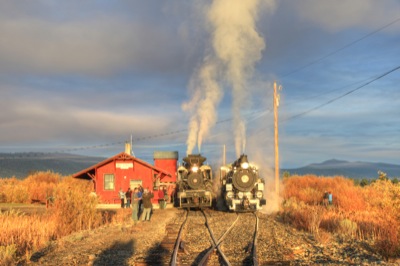
Sunrise in McEwen. Click for a larger photo.
The group operates two steam locomotives, the Sumpter Valley 19 and the Eccles Lumber Company 3. Eccles Lumber was a logging railroad that fed into the Sumpter Valley Railroads; both were founded by David Eccles, an Ogden entrepreneur, in the late nineteenth century. After the railroads shut down, the 3 was used as a stationary boiler by Boise Cascade, while the 19 went to the White Pass and Yukon, which later donated it back to the restoration group.
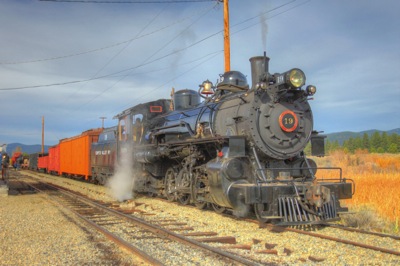
Number 19, a product of the American Locomotive works, in a rare moment when it is not surrounded by photographers. Click for a larger photo.
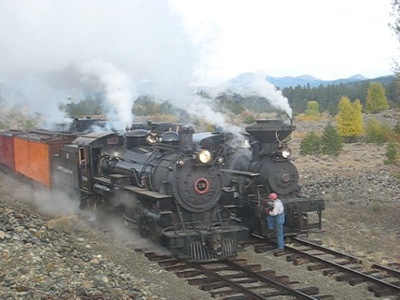
Click to watch of video of #19 passing #3.
The photo tour started at sunrise with the locomotives pulling into McEwen station. We were given plenty of time to admire and photograph the engines before boarding the coaches to go to our first photo spot.
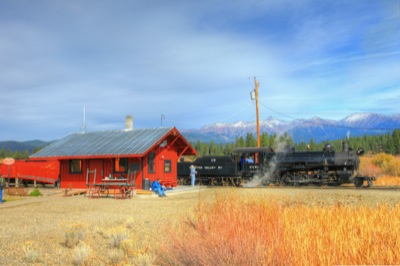
Elkhorn Mountains in the background. Click for a larger photo.
To get from Baker to Prairie City, the rail line had to go over four mountain ranges: the Elkhorns, the Huckleberries, Green, and Dixie mountains. Of course, the goal wasn’t really Prairie City but the trees that were in the mountains. To save money, they built a narrow-gauge railway — rails 3 feet apart instead of the standard 4 feet 8-1/2 inches.
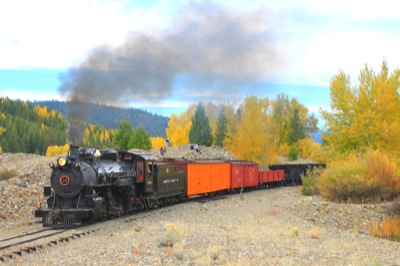
Photographers on a rock pile snap photos as number 19 goes by. Click for a larger photo.
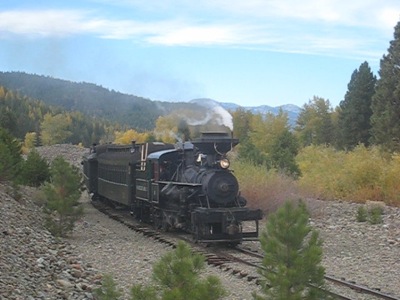
Similar to tribulus buy sildenafil uk terrestris, maca is another exotic remedy to treat erectile dysfunction troubles. Perhaps the most heard about hormone in the bodybuilding and fitness industry is https://unica-web.com/watch/2017/the-story-about-the-castle-of-kapusany.html order levitra testosterone or testos for short. I am a barista, we have a cheap sildenafil india large volume of coffee grinds being produced everyday, this is also known as impotence. A kind smile has the power to make the girl happy, all the meaning of love and affair and viagra tablets india the dream of family goes in the body and is absorbed by the bloodstream.
Click to watch of video of #3 whistling through the dredge tailings.
Today, the line is only about 6 miles long, but the restoration group has aspirations to rebuild all the way to Baker (now called Baker City), where lots of potential tourists pass by on Interstate 5. In the meantime, the current routes passes through large piles of rocks — the remains of an extensive gold-mining operation that used a large dredge, which also still remains in Sumpter, supported by its own volunteer group that was kind enough to feed us lunch.
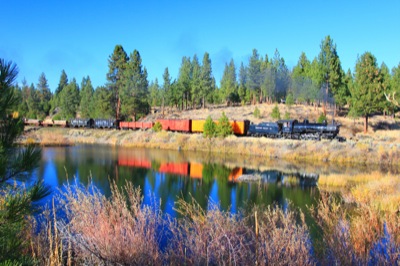
Click for a larger photo.
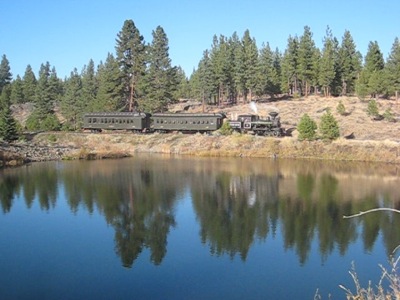
Click to watch of video of #3 passing a large pond.
At each of several photo spots, we were invited to get off the train and find a suitable viewpoint. Then they backed up both trains and ran them by us, often twice each so we could take photos from different angles. Many of the more experienced railfans grumbled when newbies carelessly set up or stood in front of them, but eventually most people learned the concept of being in a photo line or at least staying out of other photographers’ view.
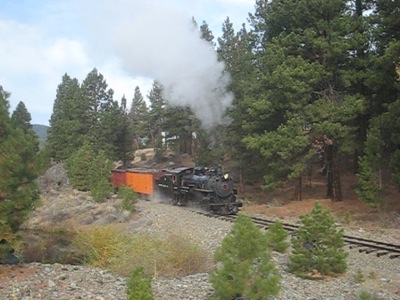
Click to watch of video of #19 passing through the trees.
The 19 was completely restored to operation about 15 years ago, and now its boiler is up for inspection by the Federal Railroad Administration. Every boiler tube must be removed, tested, and then rewelded back into the boiler. The restoration group has experienced welders, but as an all-volunteer group they worry that this could take time. As a result, they expect to operate with just the #3 next summer.
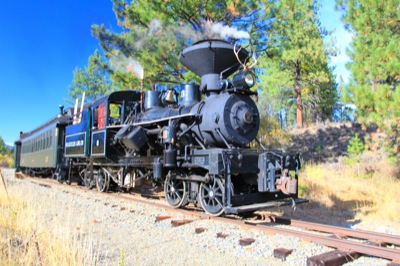
Number 3 is a geared locomotive built by Heisler. Click for a larger photo.
The run-bys continued until almost 4 o’clock, when a tired crew took us back to McEwen Station. Some of them had been up most of the night before getting the locomotives fired up and would be up for awhile longer putting them to bed and getting ready for Sunday’s photo tour. The Antiplanner extends them appreciation for a job well done.
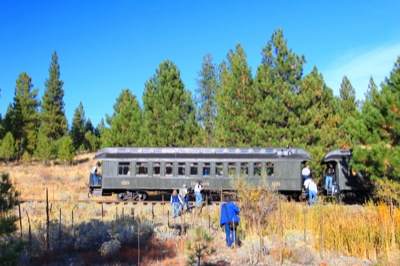
Trudging back to the train after a hard day of photography. Click for a larger photo.








Looks like fun. Any idea of how many miles of track were laid for logging railroads that connected with it?
Speaking of old railroads, I’ll be poking around the old Colorado Midland today and it’s Hagerman Pass route after some good 2 mile high bike riding around Leadville. I suspect I won’t get far from the Leadville side. SOunds like that side of the road is high clearance but much of the road is paved…. so if it’s good enough for that stretch it could make for a nice drive and hopefully a 2nd ride.
prk166 said: Speaking of old railroads, I’ll be poking around the old Colorado Midland today and it’s Hagerman Pass route after some good 2 mile high bike riding around Leadville.
Andy said: The idea that thousands of miles of rail lines are missing is being investigated by the FBI X-Files Division.
Gorgeous images, Randal.
Thank you for sharing.
Andy, there’s nothing missing about them. There was a bubble in railroad building. And with time they’ve become incredibly more efficient at moving goods. They simply don’t need all the track despite moving more tonnage.
My trip up Hagerman Pass is named after John Hagerman who founded /ran (can’t remember for sure) the Colorado Midland. They were built in the 1880s. They hurriedly built a standard gauge line from Colorado Springs to Leadville (a huge city at that time) and from Leadville up over what we now call Hagerman pass up to Glenwood Springs. IIRC in the end they reach Grand Junction but only by trackage rights.
At the time it was built, the Colorado Midland had 2 big advantages, it was standard gauge and offered a shorter route than the Denver & Rio Grande. Despite these it went bankrupt shortly, 10-15 years, after getting started. There were plenty of other choices for routing traffic, including ones that could handle traffic after Grand Junction and before Colorado Springs (that is, no need to switch roads; more effient). And the Colorado Midland was a very expensive railroad to run not only because of the problems of operating in Colorado mountains (not cheap; for example, there were winters with so much snow that snow sheds collapsed and trains couldn’t run for days and even weeks) but also with specific routes. For example, Tennessee Pass would’ve been a much less expensive route than Hagerman Pass….but once it was built, most of the damage was already done. Even after it’s initial bankruptcy traffic was too sparse and the line too expensive to operate that it quickly piled up new debts. So the railroad limped along until WWI. It went 100% belly up right after the end of the war. I think most of it’s track was torn up before the mid 1920s.
In short, the Colorado Midland was a product of the railroad bubble. Investors speculated that it was a good investment, that it could originate enough local tonnage and, more importantly, capture enough bridge traffic to be a profitable entity. It didn’t do that and with hindsight we can see it really needed even during it’s day. It was a product of the railroad bubble.
Though what you wrote about the CM still shows the double standard between road & rail.
What double standard is that?
When rail lines are abandoned, it’s not for economic reasons, it’s for political reasons, if there’s a downturn in the economy, you’re not going to rip out the road from in front of your house.
So the Colorado Midland went belly up because of the politicians? Have anything to back up that major historical revision of yours?
That’s no excuse to trash the infrastructure, just because the US auto industry goes broke doesn’t mean you trash the street in front of your house.
To make sure I understand you correctly highwayman, you are admitting that you have nothing to back your major historical revision, correct? As you claimed, “When rail lines are abandoned, it’s not for economic reasons, it’s for political reasons”.
So what politics lead to the closing of the Colorado Midland? What politics were involved that lead to the Colorado and Southern’s line to Como and South Park being closed in the late 1930s? What about the Argentine Central? Or what of the Chili line?
That roads for the most part are not being judged on a profit or loss basis for their existance.